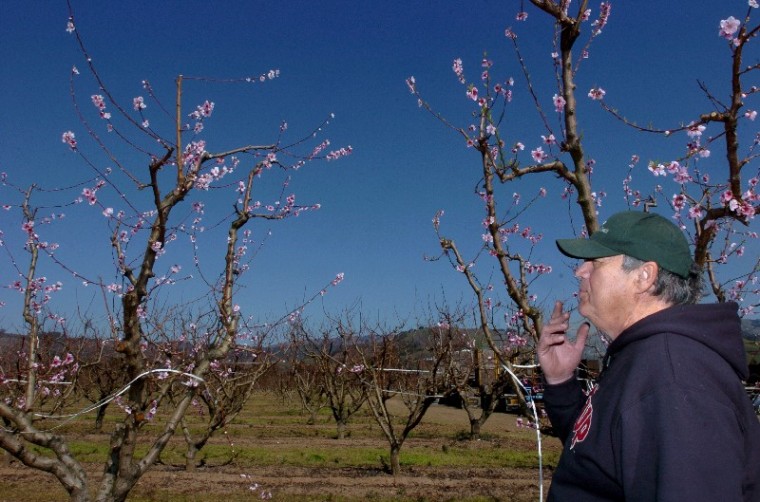
This year’s warmer winter temperatures could affect regional
orchardists
This year’s bout of unseasonably warm temperatures have fruit
growers in San Benito and southern Santa Clara counties scratching
their heads and hoping that a bountiful crop is still possible.
This year’s warmer winter temperatures could affect regional orchardists
This year’s bout of unseasonably warm temperatures have fruit growers in San Benito and southern Santa Clara counties scratching their heads and hoping that a bountiful crop is still possible.
Tree fruits need a certain amount of cold weather or “chill hours” per year to produce the best bloom and bountiful crops in the spring. However, if the trees don’t get the necessary amount of chill hours it’s like a person who doesn’t get enough sleep – they are not as productive as they would be otherwise.
The trees rely on enough cold weather for flowers and leaf buds to develop normally. If the buds do not receive sufficient chilling temperatures during winter to completely release dormancy, trees may develop symptoms such as delayed and extended bloom, delayed foliation, fewer fruit and reduced fruit quality.
Growers keep track of chilling hours beginning in November to get a sense of the orchard management practices needed and comparison of past year’s weather and crop load. The approximate number of hours needed for normal development varies depending on the type of crop and variety of that particular crop. In this region, the predominant crops are cherries, apricots, walnuts and peaches.
This winter has not produced enough chill hours for most of these crops, according to Bill Coates, farm advisor with the University of California Davis cooperative extension.
Coates deals with tree crops throughout the Central Coast. Ideally, by this time of year trees should receive about 1,000 chill hours, but the last time they actually received that amount was the period between 2001-2002, he said. During the past several years there has been a growing tendency of milder winters.
Crops such as walnuts and apples are in less danger than crops such as cherries and apricots.
“Any cold weather from here out is a nuisance, but it becomes an economic problem if we get to several weeks from now and we’re still facing the same problem,” Coates said.
Despite the warmer temperatures this year, Greg Van Wassenhove, director of agriculture for Santa Clara County, isn’t worried.
“I haven’t heard any concerns yet. Things like this, [periods of warmer weather during the winter] are called false spring traditionally, but it hasn’t been cold enough long enough to cause problems yet,” Van Wassenhove said.
He said that as the blossoms start to come out, if it continues to rain then it could cause some problems. “It’s too early to tell whether the weather is going to have an impact in this area, but my sense is that it wasn’t cold enough long enough.”
San Benito walnut grower Paul Hain generally agreed with Van Wassenhove, as far as walnuts were concerned. “This season has been a fairly normal winter, but it’s not as cold as we’d like.”
Hain said that when trees don’t get the appropriate number of chill hours the blooms can be staggered, but that the walnuts haven’t started to come out yet. He speculated that if it gets into March and April and the frost and rain are still present, it could definitely cause some problems.
Additionally, apricot growers Mark Gibson and Jim Rossi, and cherry grower Paul Rajkovich were contacted, but did not respond by press time.
Andy Mariani grows cherries, apricots, nectarines, peaches and plums near Morgan Hill and speculated that he might not be so lucky.
Typically, apricots should be starting to bloom now and they are, but they’re blooming erratically, Mariani said. Some parts of the trees are in bloom while others are still dormant. The trees could possibly be severely affected.
“My neighbor’s trees look worse than mine, they don’t look like they’re coming out of dormancy at all. Usually you see a lot of red buds before the pods open, but you don’t see that this year,” Mariani said.
He explained that it is too early to tell how things will be. The sum total of chill hours in Morgan Hill so far is only around 500. Apricots usually require about 700 hours, that’s 200 more than they’ve received thus far. Those 200 hours can account for some of the erratic bloom, but Mariani says he can’t predict any more specifically.
“So far, it’s not looking promising for cots, nectarines and peaches possibly too. We’ll know better in three to four weeks.”
Most fruit behaves OK at 600 chill hours, but at 500 hours it wants to keep sleeping, Mariani said. “In comparison, if a human goes to sleep at 11 p.m. and someone wakes them up at 2 a.m. and wants them to function normally, you don’t really respond normally and function at 100 percent. The tree is confused. It doesn’t know what to do – stay asleep or wake up. It doesn’t function.”
Other problems can also result if tree crops continue to receive rain and frost after they start to bloom, including root rot and freezing.
Hollister may be in better shape compared to Morgan Hill, since Mariani said that so far this year Hollister has had 150 more chill hours than Morgan Hill, but using the new model Morgan Hill temperatures are more in line with Hollister despite the fact that the old model said they were less.
Apricots brought in a gross value of $1.175 million and cherries earned a gross value of $1.204 million, according to the 2004 San Benito County crop report. The 2005 crop reports have not been released yet, said Ronald Ross, senior agricultural biologist with the San Benito County Department of Agriculture.









